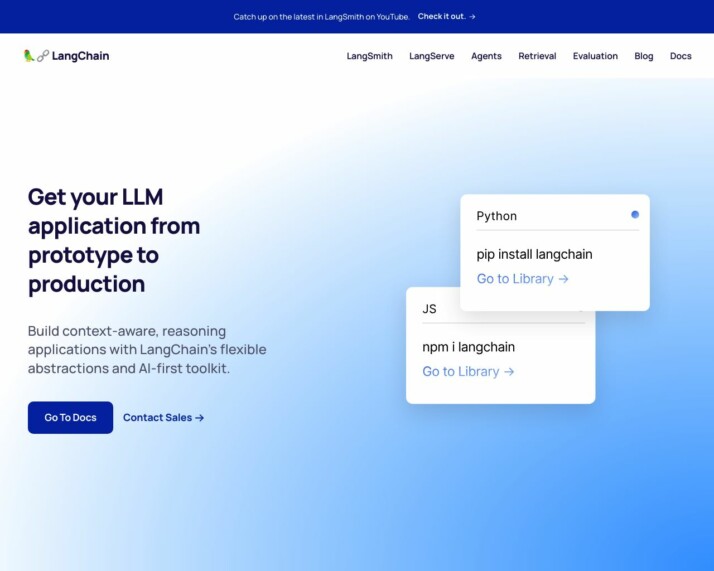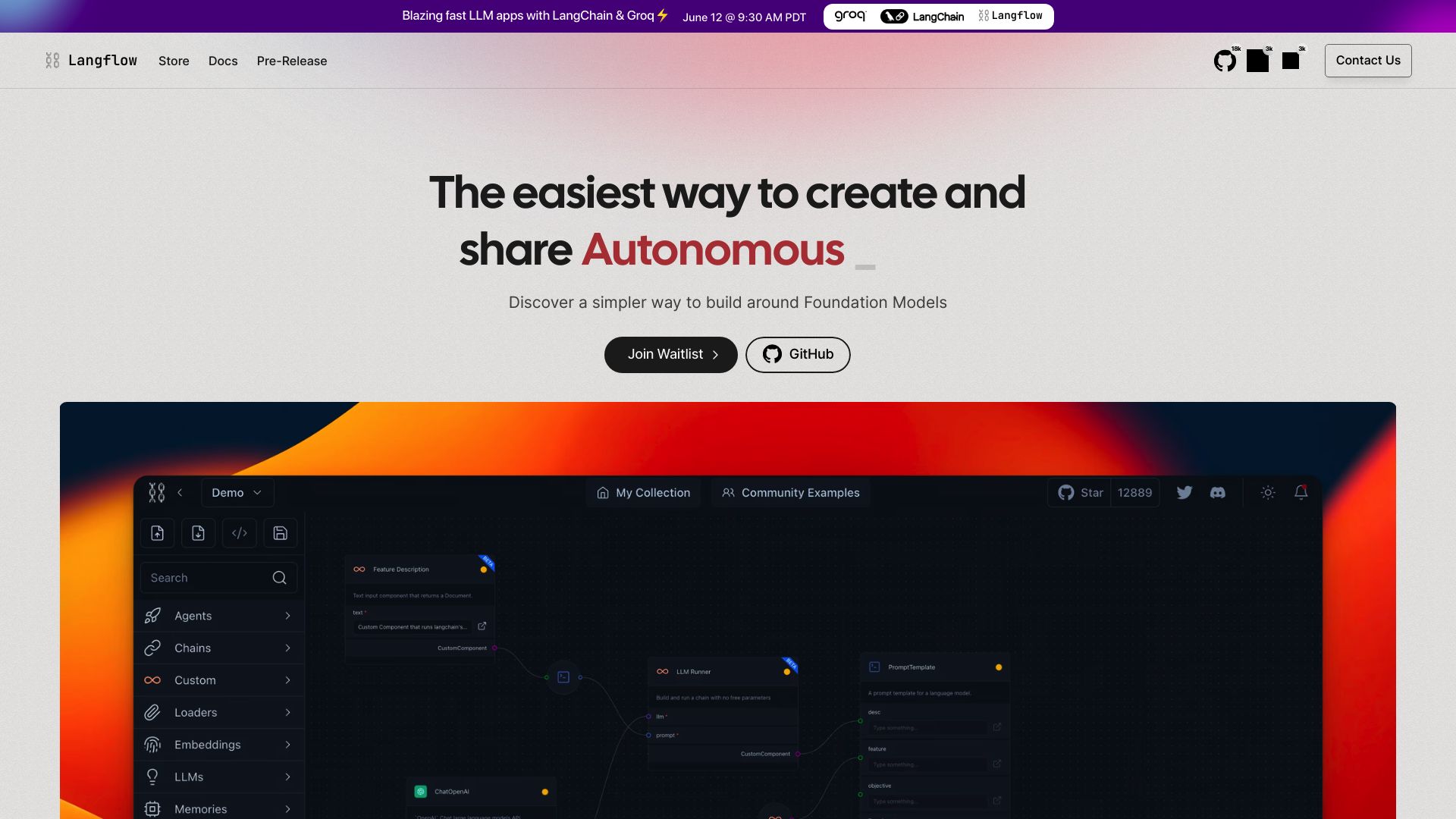AI development platforms are revolutionizing how businesses harness machine learning and language models. LangChain vs. Langflow, and SmythOS each offer unique approaches to building AI-powered applications. This comparison explores their key features, strengths, and limitations to help you choose the right tool for your AI development needs.
We’ll examine how these platforms handle complex workflows, integrate with existing systems, and cater to users with varying technical expertise. Whether you’re a seasoned developer or a business leader exploring AI solutions, this analysis provides insights to guide your decision-making process in selecting the most suitable AI development platform.
LangChain Overview
LangChain empowers developers to create sophisticated AI applications using large language models (LLMs). This open-source framework streamlines the entire LLM application lifecycle, from development to deployment. LangChain’s modular architecture provides building blocks for crafting complex AI agents, chatbots, and other LLM-powered tools.

At its core, LangChain offers a suite of libraries and components designed to simplify LLM integration. The platform’s strength lies in its flexibility, allowing developers to build custom solutions while leveraging pre-built modules for common tasks. Key features include LangGraph for creating stateful multi-actor applications, LangSmith for debugging and monitoring, and LangServe for deploying chains as REST APIs.
LangChain empowers developers to create sophisticated AI applications using large language models (LLMs). This open-source framework streamlines the entire LLM application lifecycle, from development to deployment.
LangChain shines in its ability to handle complex workflows. The LangChain Expression Language (LCEL) enables developers to chain components declaratively, with built-in support for streaming, async operations, and optimized parallel execution. This powerful abstraction layer allows for the creation of sophisticated AI agents capable of reasoning, memory retention, and multi-step problem-solving.
While LangChain offers immense potential, it does present a steeper learning curve for non-technical users. The platform primarily caters to developers and data scientists comfortable with Python programming. Additionally, as an open-source project, enterprise-grade support and certain advanced features may require additional configuration or third-party integrations.
LangChain’s integration capabilities are a major strength. The framework supports a wide array of LLM providers, vector stores, and external tools. This ecosystem approach allows developers to combine LangChain with their preferred AI models and data sources, creating highly customized solutions. For organizations looking to harness the power of LLMs while maintaining flexibility and control, LangChain presents a compelling option in the AI development landscape.
The difference-maker of integration and scale comes into play when you are pushing to ship an LLM prototype. Here LangChain is the obvious victor. It is very easy to integrate with whatever is already in place, thereby eliminating the common barriers to progress.
— Danilo Coviello, Founding Partner, Espresso Translations
Langflow Overview
Langflow revolutionizes AI application development with its open-source, low-code platform. Designed for both novice users and experienced developers, Langflow simplifies the creation of complex AI workflows through an intuitive drag-and-drop interface.
The platform excels in making AI accessible, offering a user-friendly experience that begins with straightforward installation via `pip` or `pipx`. Langflow’s standout feature is its visual programming interface, allowing users to construct sophisticated AI workflows by connecting pre-built LangChain components. This approach democratizes AI development, enabling rapid prototyping and experimentation without extensive coding knowledge.
Langflow revolutionizes AI application development with its open-source, low-code platform… simplifies the creation of complex AI workflows through an intuitive drag-and-drop interface.
Langflow enhances its offering with a powerful Command-Line Interface (CLI) for advanced users, providing granular control over project settings and configurations. Security is a top priority, with robust authentication mechanisms and customizable user management options, making it suitable for public deployments. The platform’s API integration capabilities further extend its utility, allowing programmatic access to components and workflows.

Langflow’s strength lies in its flexibility and customization potential. Users can create custom components using Python scripts, tailoring the platform to specific needs and integrating unique functionalities. This feature, combined with the chat interface and embeddable widgets, positions Langflow as a versatile tool for building interactive AI experiences.
Langflow’s strength lies in its flexibility and customization potential. Users can create custom components using Python scripts, tailoring the platform to specific needs.
While Langflow offers significant advantages in accessibility and customization, it may present a learning curve for those entirely new to AI workflows. Additionally, as a low-code solution, it might not provide the same level of control as high-code alternatives for highly specialized requirements. Scalability for large-scale deployments and complex workflows could also be a consideration for enterprise users. Despite these potential limitations, Langflow remains a powerful option for those looking to leverage AI technologies effectively, regardless of their technical background.
If your dev team prefers visual workflows over deep Python scripting, Langflow will get you to a working LLM prototype 2x faster—no question… LangChain offers fine control and a powerful abstraction layer, but it assumes strong Python fluency and architectural patience. Langflow, on the other hand, is drag-and-drop friendly and gets non-ML engineers to a working prototype within hours, not days.
— Martin Weidemann, Owner, Weidemann.tech
Feature Comparison
LangChain and Langflow offer distinct approaches to AI development, with notable feature gaps in core components and security. LangChain provides a comprehensive framework for building complex AI applications, emphasizing flexibility and customization. Its LangGraph tool enables the creation of stateful, multi-actor applications, a capability not explicitly mentioned for Langflow. LangChain’s LangSmith enhances development with robust debugging, testing, and monitoring tools, features less prominent in Langflow’s offerings.
In terms of security, LangChain incorporates OAuth for API authentication and emphasizes best practices, likely including data encryption. Langflow’s security features are less clearly defined in the available information. LangChain’s integration capabilities extend to various foundation models and APIs, including Hugging Face, offering developers a wide range of AI tools. Langflow, while user-friendly, may not match LangChain’s depth of integration options.
Langflow excels in its visual programming interface, providing an intuitive drag-and-drop experience that simplifies AI workflow creation for users with varying technical backgrounds. This low-code approach contrasts with LangChain’s more code-centric development process, potentially making Langflow more accessible to non-developers. However, this ease of use may come at the cost of some advanced functionalities and customization options that LangChain offers to more technically inclined users.
If the team is strong in Python and likes granular control, LangChain is faster… But if the team has non-technical members (product managers, UX designers or domain experts) who need to understand, tweak or co-design the prototype, Langflow wins.
— Sovic Chakrabarti, Director, Icy Tales
Feature Comparison Table
| LangChain | Langflow | SmythOS | |
|---|---|---|---|
| CORE FEATURES | |||
| Visual Builder | ❌ | ✅ | ✅ |
| No-Code Options | ❌ | ✅ | ✅ |
| Problem-Solving Capabilities | ✅ | ❌ | ✅ |
| Work as Team | ✅ | ❌ | ✅ |
| Bulk Work | ✅ | ❌ | ✅ |
| Agent Work Scheduler | ❌ | ❌ | ✅ |
| SECURITY | |||
| Constrained Alignment | ❌ | ✅ | ✅ |
| Data Encryption | ✅ | ❌ | ✅ |
| IP Control | ❌ | ❌ | ✅ |
| COMPONENTS | |||
| Foundation AIs | ✅ | ❌ | ✅ |
| Zapier APIs | ❌ | ✅ | ✅ |
| All other APIs, RPA | ✅ | ❌ | ✅ |
| Data Lakes | ❌ | ✅ | ✅ |
| DEPLOYMENT OPTIONS (EMBODIMENTS) | |||
| Deploy as API | ✅ | ❌ | ✅ |
| Deploy as Webhook | ❌ | ✅ | ✅ |
| Staging Domains | ❌ | ✅ | ✅ |
| Production Domains | ❌ | ❌ | ✅ |
| API Authentication (OAuth + Key) | ✅ | ❌ | ✅ |
| Deploy as Site Chat | ✅ | ❌ | ✅ |
| Deploy as Scheduled Agent | ❌ | ✅ | ✅ |
| Deploy as GPT | ✅ | ❌ | ✅ |
| DATA LAKE SUPPORT | |||
| Hosted Vector Database | ❌ | ✅ | ✅ |
| Sitemap Crawler | ❌ | ❌ | ✅ |
| YouTube Transcript Crawler | ❌ | ❌ | ✅ |
| URL Crawler | ❌ | ❌ | ✅ |
| PDF Support | ✅ | ❌ | ✅ |
| Word File Support | ❌ | ✅ | ✅ |
Best Alternative to LangChain and Langflow
SmythOS emerges as the superior alternative to LangChain and Langflow, offering a comprehensive agentic AI automation platform that combines powerful features with unparalleled ease of use. Our solution bridges the gap between complex AI development and user-friendly implementation, making advanced AI capabilities accessible to a broader audience.
Our visual builder sets SmythOS apart from LangChain’s code-centric approach, enabling users to create sophisticated AI workflows without extensive programming knowledge. Unlike Langflow’s limited customization options, we provide a perfect balance of simplicity and flexibility, allowing for the creation of tailored AI solutions that address specific business needs.
SmythOS emerges as the superior alternative to LangChain and Langflow, offering a comprehensive agentic AI automation platform that combines powerful features with unparalleled ease of use.
SmythOS excels in its extensive feature set, surpassing both LangChain and Langflow in critical areas. We offer robust multi-agent collaboration capabilities, enabling AI agents to work together seamlessly on complex tasks. Our platform also includes advanced scheduling features and comprehensive logs and monitoring tools, providing users with unprecedented control and visibility over their AI operations.
Security is a top priority for SmythOS, addressing concerns that may be less prominent in LangChain and Langflow. We implement stringent data encryption, IP control, and OAuth authentication, ensuring that your AI agents and sensitive data remain protected. This focus on security makes SmythOS an ideal choice for enterprises and organizations dealing with confidential information.
The first thing I always verify is federated architecture implementation – specifically that data never leaves its original environment during processing. Most people focus on encryption or access controls, but the real vulnerability is data movement itself.
— Maria Chatzou Dunford, CEO & Founder, Lifebit
With SmythOS, the possibilities for AI implementation are virtually limitless. Our platform supports a wide range of deployment options, from APIs and webhooks to site chats and scheduled agents. This versatility, combined with our extensive integration capabilities, allows users to seamlessly incorporate AI into their existing workflows and systems, regardless of the industry or use case.
Conclusion
LangChain and Langflow offer powerful tools for AI development, each with distinct strengths. LangChain provides a comprehensive framework for building complex AI applications, emphasizing flexibility and customization. Its LangGraph tool enables the creation of stateful, multi-actor applications, while LangSmith enhances development with robust debugging and monitoring capabilities. Langflow, on the other hand, excels in its user-friendly approach, offering a visual programming interface that simplifies AI workflow creation for users with varying technical backgrounds.
However, SmythOS emerges as the superior choice, combining the strengths of both platforms while addressing their limitations. Our platform offers an intuitive drag-and-drop interface similar to Langflow, making AI development accessible to a broader audience. At the same time, we provide the depth and flexibility of LangChain, supporting complex workflows and integrations with over 300,000 APIs and AI models.
SmythOS stands out with its “Create Once, Deploy Anywhere” approach, allowing seamless deployment across various platforms and services. This versatility, combined with our robust security features, scalability, and support for multimodal interactions, positions SmythOS as the ideal solution for businesses looking to harness the full potential of AI. Whether you’re a developer seeking advanced customization or a business user aiming for rapid prototyping, SmythOS offers the tools and capabilities to bring your AI projects to life efficiently and effectively.
We invite you to explore our diverse range of AI-powered agent templates and experience unlimited AI automation risk-free. With SmythOS, you can revolutionize your workflow with AI agents and unlock the power of versatile AI deployment. Start your journey towards AI-powered success today and discover how SmythOS can transform your business.